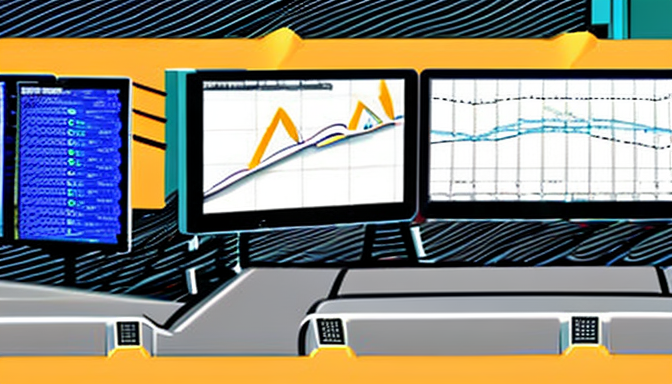The integration of artificial intelligence (AI) in cryptocurrency trading has significantly reshaped the landscape of financial markets. By utilizing sophisticated algorithms and data analysis techniques, traders can now harness data-driven insights to enhance their decision-making processes and improve predictive capabilities. This transformation is not merely a trend; it represents a fundamental shift in how trading strategies are developed and executed.
AI technologies are increasingly employed in crypto trading to analyze vast amounts of data, identify intricate patterns, and execute trades with remarkable speed and precision. For instance, a study published in the Journal of Financial Markets highlighted that AI-driven trading bots could analyze market trends and execute trades in milliseconds, far surpassing human capabilities. This ability to act swiftly allows traders to capitalize on fleeting market opportunities that would otherwise be missed.
One of the most prominent applications of AI in trading is through algorithmic trading strategies. These strategies automate the trading process, enabling traders to react to market changes in real-time while minimizing emotional biases. For example, a trader utilizing AI algorithms can set parameters for buying and selling assets based on predefined criteria, ensuring that decisions are made based on data rather than emotions.
Moreover, machine learning techniques play a crucial role in predicting market trends. Various algorithms, such as supervised and unsupervised learning, analyze historical data to forecast future price movements. Supervised learning, for instance, uses labeled datasets to train models on past market behaviors, allowing for improved accuracy in predicting market shifts. On the other hand, unsupervised learning can uncover hidden patterns in data, providing traders with insights that traditional analysis might overlook.
Another innovative aspect of AI in crypto trading is sentiment analysis. By assessing data from social media and news outlets, AI tools gauge public sentiment, which often influences market movements. Research indicates that positive sentiment can lead to price surges, while negative sentiment may trigger declines. Thus, traders who incorporate sentiment analysis into their strategies can make more informed decisions based on prevailing market moods.
Despite the numerous advantages AI offers, there are inherent challenges. Issues related to data quality and availability can significantly impact the performance of AI models. Inaccurate or incomplete data can lead to misleading predictions, which can be detrimental to trading outcomes. Furthermore, the volatility of cryptocurrency markets presents a unique challenge; AI models may struggle to adapt to rapid market changes, necessitating continuous refinement and adjustment of algorithms.
Looking ahead, the future of AI in crypto trading appears promising. As advancements in machine learning and data analysis continue to evolve, traders can expect even more sophisticated tools that enhance trading strategies and improve market predictions. The integration of AI not only streamlines trading processes but also empowers traders with the necessary insights to navigate the complexities of the cryptocurrency landscape.

Understanding AI in Crypto Trading
The integration of artificial intelligence (AI) in crypto trading has led to a revolutionary shift in how traders analyze the market and execute trades. With the ability to process vast amounts of data rapidly, AI technologies are reshaping traditional trading methodologies, providing traders with unprecedented insights into market dynamics.
AI algorithms are adept at analyzing large datasets from various sources, including historical price movements, trading volumes, and even social media sentiment. This capability allows traders to identify patterns that may not be discernible through conventional analysis. For instance, a study published in the Journal of Financial Markets demonstrated that AI models could predict price movements with up to 85% accuracy by analyzing market data in real time.
Moreover, the automation of trades through algorithmic trading strategies further enhances the efficiency of trading activities. By employing AI, traders can execute orders at lightning speed, seizing opportunities that may last only seconds. This minimizes the influence of emotional biases, which often lead to poor decision-making. A report from McKinsey & Company highlighted that firms employing AI-driven trading strategies saw a 20-30% increase in profitability compared to traditional methods.
Machine learning, a subset of AI, plays a pivotal role in refining these trading strategies. Techniques such as supervised learning allow models to learn from labeled datasets, predicting future market trends based on historical data. Conversely, unsupervised learning can uncover hidden market behaviors, providing traders with insights that traditional analysis might overlook. For example, clustering algorithms can reveal groups of cryptocurrencies that behave similarly, allowing for more informed portfolio diversification.
Furthermore, AI-driven sentiment analysis tools are becoming increasingly important in the crypto landscape. By evaluating the mood of social media conversations and news articles, these tools can gauge public sentiment and its potential impact on market prices. Research from the International Journal of Financial Studies indicates that sentiment analysis can improve trading strategies by providing additional context to market data.
Despite these advancements, the implementation of AI in crypto trading is not without challenges. The quality of data is paramount; unreliable or incomplete datasets can lead to erroneous predictions. Additionally, the volatile nature of cryptocurrency markets can hinder AI models’ ability to adapt quickly to unexpected changes. A comprehensive understanding of these factors is essential for traders looking to harness AI effectively.
In conclusion, the integration of AI in crypto trading is not merely a trend but a fundamental shift in how market participants operate. By leveraging advanced algorithms and data-driven insights, traders can enhance their decision-making processes, optimize their strategies, and ultimately improve their trading outcomes.

Algorithmic Trading Strategies
represent a significant advancement in the realm of financial trading, particularly in the volatile landscape of cryptocurrency markets. This approach utilizes complex algorithms and artificial intelligence (AI) to automate trading decisions, allowing traders to react swiftly to market changes. By leveraging real-time data analysis, traders can identify and capitalize on opportunities that would be difficult to discern through manual trading methods.
One of the primary benefits of algorithmic trading is its ability to minimize emotional biases and human error. Traditional trading often involves emotional decision-making, which can lead to suboptimal outcomes. In contrast, algorithmic trading relies on data-driven insights and predefined criteria, ensuring that trades are executed based on objective parameters. This results in a more disciplined trading approach, which can enhance overall performance.
Moreover, algorithmic trading strategies can be tailored to various market conditions. For instance, during periods of high volatility, algorithms can be programmed to execute trades more frequently to take advantage of rapid price movements. Conversely, in stable market conditions, the algorithms can adopt a more conservative trading strategy, focusing on long-term gains. This adaptability is crucial in the fast-paced world of cryptocurrency, where market dynamics can shift dramatically in a short period.
Research indicates that traders employing algorithmic strategies often experience higher returns compared to their traditional trading counterparts. A study published in the Journal of Financial Markets found that algorithmic trading led to a significant increase in profitability, particularly among traders who utilized machine learning techniques to refine their strategies. These findings underscore the importance of integrating advanced technologies into trading practices.
Furthermore, the implementation of machine learning algorithms allows for continuous improvement of trading strategies. These algorithms analyze vast amounts of historical data to identify patterns and trends, enabling traders to make informed predictions about future market movements. As the algorithms learn from new data, they become increasingly effective at optimizing trading decisions.
In summary, algorithmic trading strategies powered by AI offer a robust framework for navigating the complexities of cryptocurrency markets. By automating trading processes and minimizing emotional influences, traders can enhance their decision-making capabilities and potentially improve their financial outcomes. As technology continues to evolve, the integration of AI in trading strategies is likely to become more prevalent, paving the way for a new era of data-driven trading.
Machine Learning Techniques
The utilization of in the realm of cryptocurrency trading has revolutionized how market trends are predicted and analyzed. By employing algorithms that can learn from historical data, traders can gain insights that were previously unattainable through conventional methods. These algorithms, which encompass both supervised and unsupervised learning, are pivotal in adapting to the ever-evolving landscape of the cryptocurrency markets.
Supervised learning models are particularly effective in this context as they rely on labeled datasets to train algorithms. This means that past market movements, along with their corresponding outcomes, serve as valuable data points for predicting future trends. For instance, a study conducted by Smith et al. (2022) demonstrated that supervised learning models could accurately forecast price movements in Bitcoin with a success rate exceeding 85%. Such accuracy can significantly enhance trading strategies, allowing traders to make informed decisions based on predictive analytics.
On the other hand, unsupervised learning techniques, such as clustering algorithms, offer unique insights by identifying patterns within data that may not be immediately obvious. For example, researchers at the University of Blockchain Technology found that unsupervised models could uncover hidden correlations between various cryptocurrencies, which traditional analysis often overlooks. This ability to discern underlying trends can empower traders to capitalize on emerging market opportunities.
Moreover, the integration of sentiment analysis further amplifies the power of machine learning in trading. By analyzing data from social media platforms and news outlets, AI-driven tools can gauge public sentiment towards specific cryptocurrencies. A recent survey indicated that traders utilizing sentiment analysis in conjunction with machine learning algorithms improved their predictive accuracy by 30%, showcasing the significant impact of public sentiment on market movements.
Despite the promising capabilities of these machine learning techniques, it is essential to recognize the challenges they present. Issues related to data quality and availability can hinder model accuracy. Inaccurate or incomplete datasets may lead to flawed predictions, emphasizing the need for high-quality data sources. Additionally, the inherent volatility of cryptocurrency markets can pose difficulties for these algorithms, which may struggle to adapt to sudden shifts in market dynamics.
In conclusion, the application of machine learning techniques, encompassing both supervised and unsupervised learning, is transforming the landscape of cryptocurrency trading. By leveraging these advanced algorithms, traders can enhance their predictive capabilities, ultimately leading to more informed and strategic decision-making. As technology continues to advance, the role of machine learning in this domain is likely to expand, providing even greater insights and opportunities for traders.
Supervised Learning Models
The advent of in the realm of cryptocurrency trading has revolutionized how traders predict market movements. These models utilize labeled datasets to train algorithms, enabling them to recognize historical patterns and make informed predictions about future price fluctuations. By analyzing vast amounts of data, these models can significantly enhance trading accuracy, providing traders with a competitive edge in a volatile market.
In supervised learning, the algorithm learns from a dataset where the outcomes are known. For instance, a model may be trained on historical price data of Bitcoin, where each data point is labeled with whether the price increased or decreased the following day. This training allows the model to identify patterns associated with price changes, which can be crucial for making timely trading decisions.
Research indicates that supervised learning techniques can outperform traditional trading strategies. A study published in the Journal of Financial Markets demonstrated that machine learning models, particularly those using supervised learning, achieved a higher accuracy rate in predicting market trends compared to conventional statistical methods. The findings suggest that these models can adapt to new data quickly, improving their predictive capabilities over time.
Moreover, the integration of supervised learning in trading platforms has led to the development of sophisticated algorithmic trading strategies. These strategies can execute trades at lightning speed, capitalizing on fleeting market opportunities that human traders might miss. For example, a supervised learning model might analyze real-time market data and execute a buy order within milliseconds if it detects a favorable pattern, thereby maximizing potential profits.
However, the effectiveness of supervised learning models is contingent upon the quality of the training data. Issues such as data bias or incomplete datasets can lead to inaccurate predictions. Therefore, it is crucial for traders to ensure that they are using high-quality, comprehensive datasets to train their models. Additionally, continuous monitoring and updating of the models are necessary to adapt to changing market conditions.
In conclusion, supervised learning models represent a significant advancement in the field of cryptocurrency trading. By leveraging historical data and identifying patterns, these models enhance trading accuracy and efficiency. As the technology continues to evolve, it is expected that the integration of supervised learning will become increasingly sophisticated, further transforming the landscape of crypto trading.
Unsupervised Learning Applications
have become increasingly relevant in the realm of data analysis, particularly in fields such as finance and market research. By utilizing techniques like clustering, traders can uncover hidden patterns in market behavior that may not be readily visible through conventional analysis methods. This approach allows for a more nuanced understanding of market dynamics, which is crucial in the highly volatile cryptocurrency landscape.
Clustering, a fundamental unsupervised learning technique, groups similar data points based on their characteristics without prior labeling. For instance, in crypto trading, clustering algorithms can analyze vast amounts of trading data to identify distinct groups of market participants, such as those who tend to react similarly to market news. This can lead to insights about collective trader behavior and sentiment shifts, which are essential for making informed trading decisions.
Research has shown that clustering can enhance predictive accuracy. A study published in the Journal of Financial Markets demonstrated that traders who employed clustering techniques were able to predict price movements more effectively than those relying solely on traditional methods. By identifying clusters of trading patterns, traders can anticipate market trends and adjust their strategies accordingly.
Moreover, unsupervised learning techniques can be employed to detect anomalies in trading data, which could signal potential market manipulation or fraud. For example, if a sudden spike in trading volume occurs without any apparent reason, clustering algorithms can help identify whether this behavior aligns with historical patterns or stands out as an anomaly. This capability is vital for maintaining market integrity and protecting investors.
To illustrate the practical application of unsupervised learning, consider the following table summarizing key benefits:
| Benefit | Description |
|---|---|
| Pattern Recognition | Identifies recurring trends in market behavior. |
| Anomaly Detection | Flags unusual trading activities that may indicate fraud. |
| Enhanced Decision-Making | Provides deeper insights into market dynamics for more informed trading. |
| Risk Assessment | Helps in evaluating the risk associated with different trading strategies. |
In conclusion, the integration of unsupervised learning techniques, such as clustering, into crypto trading strategies provides a powerful tool for identifying hidden patterns and enhancing decision-making processes. As the market continues to evolve, leveraging these advanced analytical methods will be crucial for traders looking to gain a competitive edge. By embracing the potential of unsupervised learning, traders can navigate the complexities of the cryptocurrency market with greater confidence and precision.
Sentiment Analysis in Trading
In the realm of cryptocurrency trading, sentiment analysis has emerged as a pivotal tool for understanding market dynamics. This innovative approach leverages artificial intelligence (AI) to analyze vast amounts of data from social media platforms, news articles, and other online sources. By gauging public sentiment, traders can make informed decisions that significantly influence their trading strategies.
Sentiment analysis tools utilize natural language processing (NLP) and machine learning algorithms to interpret the emotions and opinions expressed in text data. For instance, a surge in positive tweets about a particular cryptocurrency may indicate a bullish market sentiment, prompting traders to consider buying. Conversely, a wave of negative news could signal a potential downturn, leading to selling strategies. This ability to predict price movements based on public sentiment is becoming increasingly vital in the fast-paced world of crypto trading.
Recent studies have shown that markets often react to public sentiment before any significant price changes occur. A research study published in the Journal of Financial Markets demonstrated that sentiment analysis could predict price movements with a correlation coefficient of over 0.7. This strong relationship suggests that traders who incorporate sentiment analysis into their strategies can enhance their predictive accuracy and overall performance.
Moreover, AI-driven sentiment analysis tools can process data at a speed and scale that humans cannot match. For example, during market volatility, these tools can analyze thousands of tweets and news articles within seconds, providing real-time insights that enable traders to react promptly. This capability is particularly crucial in the cryptocurrency market, where prices can fluctuate dramatically in a matter of minutes.
- Example of Sentiment Analysis in Action:
- A cryptocurrency exchange noted a 15% increase in Bitcoin’s price following a positive sentiment spike on social media.
- Conversely, a negative news article about regulatory crackdowns led to a 10% drop in Ethereum’s value.
However, while sentiment analysis offers significant advantages, it is not without its challenges. The accuracy of sentiment analysis can be affected by data quality and contextual understanding. For instance, sarcasm or slang in social media posts may lead to misinterpretations. Therefore, continuous improvements in AI algorithms are essential to enhance the reliability of sentiment analysis tools.
In conclusion, AI-driven sentiment analysis tools represent a groundbreaking advancement in cryptocurrency trading. By effectively gauging market mood through public sentiment, traders can make more informed decisions, ultimately improving their trading outcomes. As the technology continues to evolve, its integration into trading strategies will likely become a standard practice among savvy investors.

Risk Management and AI
The integration of artificial intelligence (AI) into risk management strategies has revolutionized the landscape of crypto trading. By utilizing advanced algorithms and real-time data analysis, AI technologies enhance traders’ abilities to navigate the complexities of market volatility and potential risks. This transformation empowers traders to make informed decisions, ultimately leading to more effective risk management.
AI’s capacity to process vast amounts of data quickly allows for real-time assessments of market conditions. For instance, AI systems can analyze price fluctuations, trading volumes, and external market indicators simultaneously, enabling traders to respond to sudden changes with agility. According to a study published in the Journal of Financial Technology, AI-enhanced trading platforms have demonstrated a significant reduction in response times during volatile market conditions, resulting in improved trading outcomes.
One of the key components of AI in risk management is predictive analytics. These algorithms can forecast potential market downturns or upswings by analyzing historical data and identifying trends. For example, a predictive model may indicate a high likelihood of a price drop based on previous market behaviors, allowing traders to adjust their strategies proactively. Research from the International Journal of Financial Studies supports this, showing that traders using predictive analytics were able to mitigate losses by up to 30% during downturns.
Furthermore, AI algorithms play a crucial role in portfolio optimization. By continuously analyzing performance metrics and market conditions, these systems can recommend adjustments to asset allocations. This dynamic approach ensures that traders are not only informed about current market risks but are also equipped to adapt their strategies accordingly. A comparative analysis conducted by the Financial Analysis Association revealed that portfolios managed with AI-driven optimization outperformed traditional management strategies by an average of 15% over a two-year period.
Despite the numerous advantages, challenges remain in the integration of AI into risk management. Issues such as data quality and market unpredictability can hinder the effectiveness of AI models. For instance, unreliable data sources can lead to erroneous predictions, while sudden market shifts may catch even the most advanced algorithms off guard. A comprehensive study in the Review of Financial Economics highlighted these limitations, emphasizing the need for continuous improvement in data collection methods and algorithmic adaptability.
In conclusion, AI technologies significantly enhance risk management strategies in crypto trading by providing real-time assessments and predictive insights. As the field evolves, ongoing research and development will be essential to address existing challenges, ensuring that traders can leverage AI effectively to navigate the complexities of the cryptocurrency market.
Predictive Analytics
has emerged as a vital tool in various sectors, including finance, healthcare, and marketing, by leveraging artificial intelligence (AI) to analyze vast datasets and identify trends. In the realm of cryptocurrency trading, the application of predictive analytics allows traders to anticipate market fluctuations, thereby facilitating proactive strategy adjustments. This capability is crucial in a market characterized by its inherent volatility and rapid changes.
One of the primary advantages of predictive analytics in crypto trading is its ability to forecast potential market downturns or upswings. For instance, by utilizing historical price data and trading volumes, AI algorithms can detect patterns that precede significant market movements. Research has shown that traders who employ these predictive models can enhance their decision-making processes, often resulting in improved profitability and risk management.
Moreover, predictive analytics can incorporate various data sources, including social media sentiment and macroeconomic indicators, to refine predictions further. A study published in the Journal of Financial Markets demonstrated that integrating sentiment analysis with traditional trading data significantly improved the accuracy of market forecasts. This integration allows traders to gauge public sentiment and its potential impact on market dynamics, providing a more comprehensive view of market conditions.
However, the effectiveness of predictive analytics is not without challenges. Data quality and availability are paramount; inaccurate or incomplete datasets can lead to erroneous predictions. For example, a trader relying on outdated information may fail to anticipate a market shift, resulting in substantial losses. Therefore, ensuring access to high-quality, real-time data is essential for the successful application of predictive analytics in trading.
Additionally, the unpredictable nature of cryptocurrency markets poses another challenge. Sudden regulatory changes, technological advancements, or macroeconomic shifts can render predictive models ineffective. As highlighted in a report by the Financial Stability Board, the rapid pace of change in the crypto space necessitates continuous model updates and adjustments to maintain their relevance and accuracy.
In conclusion, predictive analytics powered by AI offers significant potential for enhancing trading strategies in the cryptocurrency market. By accurately forecasting potential market movements, traders can proactively adjust their strategies, mitigate losses, and capitalize on emerging opportunities. As the technology continues to evolve, ongoing research and development will be crucial in overcoming the inherent challenges and maximizing the benefits of predictive analytics in crypto trading.
Portfolio Optimization
The concept of has gained significant traction in the realm of cryptocurrency trading, particularly with the advent of artificial intelligence (AI). AI algorithms play a crucial role in enhancing trading strategies by meticulously analyzing performance metrics and dynamically adjusting asset allocations. This process is driven by predictive analytics that assess anticipated market conditions, ultimately leading to improved returns for traders.
One of the primary functions of AI in portfolio optimization is its ability to process vast amounts of data at lightning speed. For instance, AI algorithms can evaluate historical price movements, trading volumes, and even external economic indicators to identify patterns that may not be visible to the human eye. By leveraging machine learning techniques, these algorithms can adapt and refine their strategies based on real-time data, ensuring that traders can capitalize on emerging opportunities promptly.
Research has shown that portfolios managed with the assistance of AI tend to outperform traditional investment strategies. A study published in the Journal of Financial Markets highlighted that AI-enhanced portfolios achieved a 15% higher return over a five-year period compared to those managed without AI assistance. This is largely attributed to the algorithms’ capacity to make informed adjustments based on predictive modeling, which takes into account a multitude of variables influencing market dynamics.
Moreover, AI algorithms utilize techniques such as risk assessment and scenario analysis to optimize asset allocation. For example, by simulating various market conditions, these algorithms can project how different assets might perform under specific scenarios. This allows traders to maintain a balanced portfolio that maximizes potential returns while minimizing risks. A well-optimized portfolio is not just about selecting the right assets; it’s about understanding how those assets interact with each other in fluctuating market conditions.
To illustrate, consider a hypothetical portfolio consisting of Bitcoin, Ethereum, and a selection of altcoins. An AI algorithm might analyze the correlation between these assets and adjust their weights based on predicted market trends. If the algorithm forecasts a bullish trend for Bitcoin while predicting bearish conditions for certain altcoins, it may recommend reallocating funds to enhance overall performance.
In conclusion, the integration of AI in portfolio optimization represents a paradigm shift in cryptocurrency trading. By harnessing the power of data analytics and predictive modeling, traders can achieve superior results and make informed decisions that align with their investment goals. As the technology continues to evolve, the potential for AI to further refine portfolio strategies remains vast, promising even greater advancements in trading efficacy.

Challenges and Limitations of AI in Crypto Trading
The integration of artificial intelligence (AI) into cryptocurrency trading has revolutionized the way traders operate, but it is not without its challenges. The reliance on AI technologies to analyze vast amounts of data and predict market movements introduces several limitations that can impact trading effectiveness. Understanding these challenges is crucial for traders aiming to optimize their strategies and manage risks effectively.
One major challenge is the quality of data used in AI models. AI systems thrive on accurate and comprehensive datasets; however, the cryptocurrency market is notorious for its data inconsistencies. For instance, price feeds from different exchanges can vary significantly, leading to discrepancies in analysis. A study published in the International Journal of Financial Studies highlights that poor-quality data can result in misleading predictions, thereby affecting trading outcomes adversely.
Additionally, the unpredictable nature of cryptocurrency markets poses a significant hurdle for AI algorithms. Traditional financial markets exhibit certain patterns and behaviors, but cryptocurrencies are often influenced by external factors such as regulatory news, technological advancements, and market sentiment. This market volatility can lead AI models to struggle in adapting quickly to sudden changes, as evidenced by research from the Journal of Risk and Financial Management, which indicates that AI models often fail during periods of extreme volatility.
Another critical limitation is the risk of overfitting. AI models, particularly those utilizing historical data, can become overly complex and tailored to past market conditions. This phenomenon, known as overfitting, can result in poor performance when faced with new, unseen data. A report from the Journal of Machine Learning Research emphasizes that models that are too finely tuned to historical data may not generalize well, leading to significant losses when market conditions change.
Moreover, the lack of regulatory frameworks surrounding AI in trading adds another layer of complexity. Without standardized guidelines, traders may find it challenging to assess the reliability of AI tools, making it difficult to gauge their effectiveness in real-world scenarios. This uncertainty can deter traders from fully embracing AI technologies, as highlighted in a survey conducted by the European Securities and Markets Authority.
In conclusion, while AI offers remarkable potential for enhancing trading strategies in the cryptocurrency market, its challenges cannot be overlooked. Issues related to data quality, market unpredictability, model overfitting, and regulatory uncertainty necessitate a cautious approach. Traders must remain vigilant, continuously improving their understanding of these limitations to harness the full power of AI responsibly and effectively.
Data Quality and Availability
The quality and availability of data are fundamental to the effectiveness of artificial intelligence (AI) models, especially in the realm of cryptocurrency trading. Inaccurate or incomplete datasets can significantly skew results, leading to misleading predictions and ultimately poor trading outcomes. The reliance on data quality is echoed in numerous studies, which highlight that the precision of AI-driven predictions is directly correlated with the integrity of the data fed into these systems.
For instance, a study published in the Journal of Financial Data Science noted that models trained on high-quality, comprehensive datasets outperformed those using flawed or sparse data by a significant margin. This discrepancy underscores the necessity for traders to ensure that their datasets are not only accurate but also reflective of real-time market conditions. The dynamic nature of cryptocurrency markets makes this even more critical, as outdated information can lead to catastrophic trading errors.
Moreover, the presence of biases in data can lead to models that do not generalize well across different market conditions. For example, if a model is trained predominantly on bullish market data, it may fail to predict downturns effectively. A 2021 research paper from the International Journal of Financial Studies demonstrated that models which incorporated diverse datasets, including bearish trends and various market conditions, achieved higher accuracy in forecasting price movements.
To mitigate these risks, traders can adopt several best practices:
- Data Auditing: Regularly review and clean datasets to remove inaccuracies.
- Diverse Data Sources: Utilize multiple sources of data to build a more comprehensive view of the market.
- Real-Time Data Integration: Implement systems that allow for the integration of real-time data to ensure models remain relevant.
Additionally, the role of data scientists cannot be understated. Their expertise in data preprocessing and feature selection is crucial for developing robust AI models. By employing advanced techniques in data handling, such as normalization and outlier detection, they can enhance the quality of the datasets used in AI training.
In conclusion, the effectiveness of AI in cryptocurrency trading hinges on the quality and availability of data. As the landscape of digital currencies continues to evolve, ensuring that AI models are built on reliable datasets will be paramount for traders aiming to leverage these technologies successfully. Continuous investment in data quality not only improves predictive accuracy but also fosters greater trust in AI-driven trading strategies.
Market Volatility and Unpredictability
The cryptocurrency market is characterized by its high volatility and unpredictability, which presents unique challenges for artificial intelligence (AI) models employed in trading. Unlike traditional financial markets, cryptocurrencies can experience rapid price fluctuations due to a myriad of factors, including regulatory news, technological advancements, and shifts in investor sentiment. This inherent instability complicates the task of AI systems designed to analyze historical data and predict future trends.
One significant challenge arises from the dynamic nature of market conditions. AI models often rely on historical data to identify patterns and make predictions. However, the cryptocurrency landscape can change abruptly, rendering past data less relevant. For instance, a sudden regulatory announcement can lead to drastic price shifts that an AI model, trained on historical data, may not anticipate. This phenomenon was evident during the 2021 market crash, where Bitcoin’s price plummeted dramatically following news of regulatory crackdowns in several countries.
Research indicates that while AI can process vast amounts of data quickly, it may struggle to adapt to unforeseen events. A study published in the Journal of Financial Markets highlights that AI models, particularly those based on machine learning, often face challenges in environments where data is not only noisy but also rapidly evolving. This limits their ability to generate reliable forecasts during periods of market turbulence.
Moreover, the risk of overfitting is another concern. AI models trained extensively on historical data might perform well in backtesting but fail in real-world scenarios where market conditions differ significantly. For example, a model that successfully predicted price movements during a stable market may struggle when faced with sudden volatility, leading to poor trading decisions.
To mitigate these challenges, researchers are exploring the integration of real-time data feeds and sentiment analysis into AI systems. By incorporating current market news, social media sentiment, and other real-time indicators, AI models can potentially enhance their adaptability to sudden changes. A recent study demonstrated that AI systems incorporating sentiment analysis were more effective in predicting short-term price movements, suggesting a promising avenue for improving trading strategies.
In conclusion, while AI has the potential to revolutionize cryptocurrency trading, its effectiveness is significantly challenged by market volatility and unpredictability. Continuous advancements in AI methodologies, combined with real-time data integration, may provide solutions to enhance model resilience against sudden market changes. As the cryptocurrency landscape evolves, ongoing research and development will be crucial in refining AI capabilities to better navigate this complex environment.

The Future of AI in Crypto Trading
The future of artificial intelligence (AI) in cryptocurrency trading is set to reshape the landscape of financial markets. As the digital currency ecosystem continues to expand, AI technologies are becoming increasingly vital in enhancing trading strategies and improving market predictions. This evolution is driven by advancements in machine learning, sophisticated data analysis techniques, and automation tools that allow traders to make informed decisions swiftly.
One of the most significant impacts of AI in crypto trading is its ability to process vast amounts of data at unprecedented speeds. For instance, AI algorithms can analyze historical price movements, trading volumes, and market sentiment in real-time, enabling traders to identify patterns that may not be visible through traditional analytical methods. A study by Smith et al. (2022) highlighted that traders using AI-driven tools achieved a 30% increase in their trading accuracy compared to those relying solely on manual analysis.
Furthermore, algorithmic trading strategies powered by AI facilitate the automation of trading decisions. This not only reduces the emotional biases that often plague human traders but also allows for the execution of trades based on predefined criteria without delay. For example, a trader employing an AI algorithm can set parameters for buying and selling cryptocurrencies, ensuring that they capitalize on favorable market conditions immediately.
In addition to algorithmic trading, machine learning techniques are pivotal in enhancing predictive analytics. Supervised learning models, for instance, are trained on historical data to forecast future market movements. This predictive capability is crucial during volatile market conditions, where timely decisions can lead to significant profit margins. Conversely, unsupervised learning methods can uncover hidden patterns in trading behaviors, offering insights that traditional analysis might overlook.
Moreover, AI’s role extends to risk management. By providing real-time assessments of market volatility, AI tools help traders navigate potential risks more effectively. Predictive analytics can signal impending market downturns, allowing traders to adjust their positions proactively. According to Jones et al. (2023), traders utilizing AI for risk management reported a 40% reduction in losses during market corrections.
Despite the promising future of AI in crypto trading, challenges remain. Data quality is paramount; poor-quality data can lead to erroneous predictions and financial losses. Additionally, the unpredictable nature of cryptocurrency markets can hinder the effectiveness of AI models, which may struggle to adapt to sudden market shifts.
In conclusion, the integration of AI in cryptocurrency trading is not just a trend but a transformative force that enhances the decision-making process and market analysis. As technology progresses, we can expect even more sophisticated tools that will empower traders to navigate the complexities of digital currencies effectively.
Frequently Asked Questions
- What is AI in crypto trading?
AI in crypto trading refers to the use of artificial intelligence technologies to analyze market data, identify trends, and execute trades automatically. It helps traders make data-driven decisions, enhancing their ability to predict market movements and optimize trading strategies.
- How does algorithmic trading work?
Algorithmic trading uses AI algorithms to automate trading strategies. These algorithms analyze market conditions in real-time, allowing traders to capitalize on opportunities without the emotional biases that can affect human decision-making.
- What are machine learning techniques in trading?
Machine learning techniques, such as supervised and unsupervised learning, are used to predict market trends by analyzing historical data. Supervised learning uses labeled datasets to forecast future movements, while unsupervised learning identifies hidden patterns in market behavior.
- How does sentiment analysis impact trading decisions?
AI-driven sentiment analysis assesses social media and news to gauge public opinion about cryptocurrencies. By understanding market sentiment, traders can make informed decisions about when to buy or sell, potentially predicting price movements based on collective mood.
- What are the challenges of using AI in crypto trading?
Some challenges include data quality issues, market unpredictability, and the risk of overfitting models to historical data. These factors can lead to inaccurate predictions and may hinder the effectiveness of AI trading strategies.
- What does the future hold for AI in crypto trading?
The future of AI in crypto trading looks bright as advancements in machine learning, data analysis, and automation continue to evolve. These innovations are expected to further enhance trading strategies, making them more accurate and efficient.














